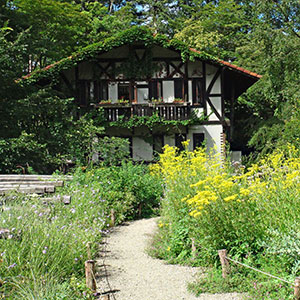Transplanting classic English country gardens into a brutal habitat
The quaint image of a lavender-lined path and pink roses trained around the door of a thatched cottage is one that many Japanese bring back from a visit to the UK. And despite Japan’s own considerable gardening heritage, some want to recreate their very own English garden here. But it’s not nearly as easy as it might seem, warns Nicholas Lenaghan, who has designed about 50 gardens here in what he describes as a fusion of the best components of England and Japan into the “modern cottage” style.
“The gardens that I design have an English base, but I have developed my own style that uses a lot of Japanese plants”, said Lenaghan, 35, who is originally from East Lothian and arrived here 10 years ago. “Summers here are not English and can be brutal on gardens, so I have to choose plants that will be able to survive”, he said. “Equally, winters can be warm, but very dry and bleak in Tokyo. That can be a challenge for plants, especially in new gardens”.
And it is not only the elements that make recreating an English garden tough, even for someone with green fingers. Deer, wild boar and even bears are additional hazards with which he has had to contend. “I get a lot of people who have been to England and show me pictures of the classic garden that they want me to reproduce for them, but I find that over time and by explaining I can usually talk them round”, said Lenaghan, who studied landscape design and plant science at the University of Sheffield before attending The Mackintosh School of Architecture in Glasgow.
Still, a lot of features and plants that would be perfectly at home in a garden in Buxton or Bournemouth can be transplanted to Japan, said Lenaghan, who lives in the Nagano Prefecture town of Suwa and set up Nico Garden & Interior in 2007. His major projects have included creating a flower garden to break up the long fairways of Tsutsujigaoka Country Club Golf Course, in Tochigi Prefecture, using a combination of perennial plants with ornamental grasses. This creates a more natural aesthetic, he said, with perennials such as echinaceas and monardas mixing with grasses such as panicum and miscanthus to create a softer, more flowing style. New Zealand flax and pampas grasses add a “rhythm” and a degree of drama to the overall effect, he said.
Another long-running project is part of the grounds of Jomyoji Temple in Kamakura, a garden that Lenaghan first worked on shortly after arriving in Japan. A building within the temple compound was designed and built by a German 70 years ago and the wife of the temple’s head monk wanted to turn part of the building into a bakery with a garden that matched the European aesthetic. The result is a round pool with a grindstone as a centrepiece; a symmetrically laid out herb garden with water features and a sundial on a plinth imported from England, extensive lawns and a riot of colours in the flowering beds throughout the year.
Nico Garden and Interior
Tel: 0266-58-6587
info (at) nico-garden.com
www.nico-garden.com






